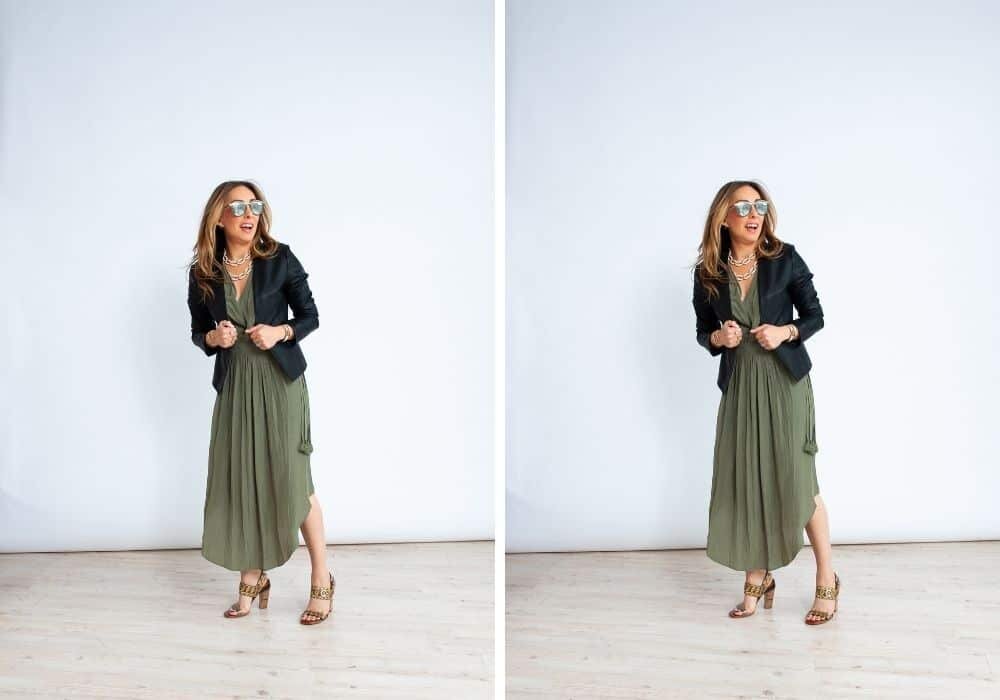Transitional Dressing: What to Wear When the Calendar Says Fall but it Feels Like Summer
What to Wear When the Calendar Says Fall but it Feels Like Summer
My Jewish readers know the drill. Are the High Holidays early this year? Or late? It’s always a question, year after year. Because unlike Christmas that falls on December 25 every single year, the Jewish calendar is lunar. So our major holidays are always changing. For instance, in 2016, Rosh Hashanah began on October 2, and Hanukkah was on December 24. This year Rosh Hashanah falls on LABOR DAY!! Like, the actual Monday of Labor Day, AKA the official end of summer. According to some outdated fashion rule, it’s also the day you have to stop wearing white clothing (until the next summer, marked by Memorial Day). Just as an aside, I think that rule is total rubbish and you do not need to follow it. But that’s probably more for another column.
Anyway, Rosh Hashanna, for me, marks the beginning of autumn. It’s the big fall kick-off. The Jewish holiday version of the September issue of Vogue. In fact, as a girl, when my mom would take me on our annual back-to-school clothes shopping outing (because back then it was a good thing to outgrow your clothes each year – at my age now, not so much!) One of the most important items to check off the list was a new Rosh Hashanah outfit.
Rosh Hashanah Usually Means Fall Clothes
Normally, my New Year’s outfit (Rosh Hashanah is considered the Jewish New Year) would be in a fabric or color that felt like fall – think wool, corduroy, or velvet and in colors like brown, camel, or burgundy. Nice rich colors and fabrics that are on point for colder weather. The same way there are distinct foods one associates with certain holidays that make it “feel” like that occasion, so too with specific garments.
I vividly remember the feeling of wearing my new outfit to every Rosh Hashanna family dinner and then to synagogue. And then I’d wear it again for the school holiday concert and any other colder weather events we had. Until, of course, it was time to shop for my new spring outfit (this time it was for Passover).
This shopping ritual to mark important milestones is not just a “Jewish thing.” My Christian friends had similar seasonal shopping experiences. However, their touchstone holidays were usually Christmas and Easter. Ya know, same song, different tunes.
But, It’s Labor Day!
But this year, with Rosh Hashanah landing literally on Labor Day – a day I think of as reserved for pool parties and backyard BBQ’s – it’s throwing the whole what-to-wear, fall-debut, thing off. Big Time. Personally, as much as I might sacrifice comfort for fashion on occasion, wearing wool tweed when it’s 80 degrees outside is a definite NO in my book. Honestly, I’m sweating just thinking about it.
So the big question is what are we to wear for Rosh Hashanah 2021? The answer: something that’s covered but lightweight. Breathable for outside but can keep you warm in the air-conditioned synagogues. And is on the more modest side, because, let’s be honest, what we wear to a house of worship should be slightly more conservative than what you’d wear to a club.
Ok, so let’s chat about how to ring in fall and the new year (this year it’s going to be 5782!!) and not melt…
And, BTW, this styling tip is not only for my Jewish readers… there are all kinds of events (work-related, family festivities) that happen when we think it’s autumn, but the thermometer says otherwise. This type of transitional dressing works really well for fall and for spring – the times when it’s usually the hardest to get dressed.
Q: So what exactly should we wear for Rosh Hashanah 2021?
A: Transitional Dresses and Suits – Seasonless Pieces
I like to call this transitional dressing – it’s basically outfits that are seasonless OR outfits that can “transition” from season to season with the change of a key piece or two. It will allow you to wear the majority of your clothes, 12 months a year.
My picks for both men and women is to wear a lightweight, season-less fabric such as worsted wool, silk, or a poly blend. That way, the outfit can be either a warm-weather outfit or a cold-weather outfit. All you have to do is change up your footwear or add/subtract a layer.
What does Transitional Dressing Look Like For Women?
Well, a long-sleeved silk dress with pumps or dress sandals would be perfect for Rosh Hashanah this year. And adding tights and boots (along with maybe a topper such as a leather jacket or chunky sweater) could bring that same dress in to the colder months. A sleeveless dress can be worn on September 6th, 7th, 8th with a light dress cardigan over it. And when it gets colder, it can be worn over a second skin turtleneck as a jumper.
And What Does Transitional Dressing Look Like For Men?
For the gents, it’s somewhat similar, but in reality, men’s dressing is less complicated than women’s. Most men’s suits are made from a season-less fabric. And most of the time, the guys are not wearing sandals with their dress clothes. So the way gentlemen’s High Holiday outfits will read more temperature appropriate is through their color choices and accessories. A light grey suit compared to a dark grey suit. That being said, a dark suit can be lightened up by adding a lighter color shirt/tie combo. And even more so by adding a lighter color shoe and a fun sock.



